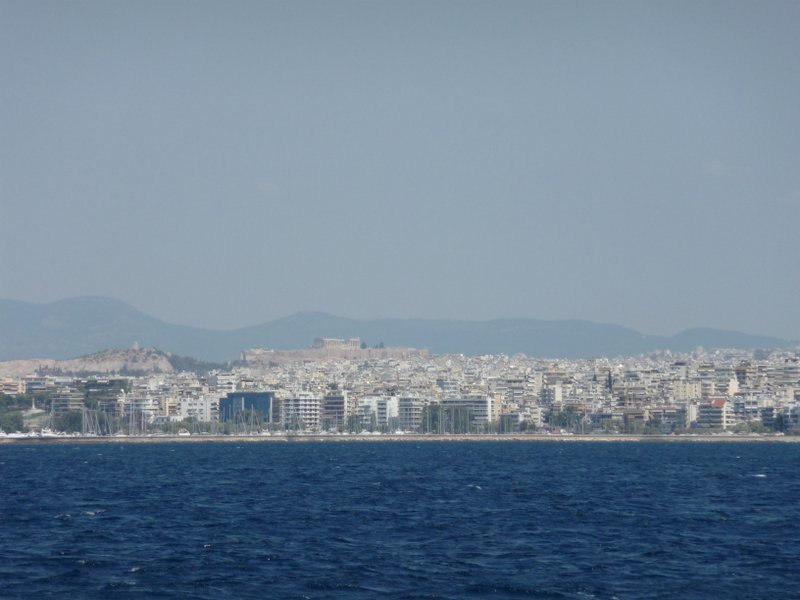From the Turkish town of Cesme it was a short, eight-mile hop back to Greece and the island of Chios. We slipped away early in the morning before the mighty Meltemi began to blow and we found plenty of space to Med-moor on the quay in Chios town.
All the offices of officialdom were well hidden on the opposite corner of the harbor near the ferry terminal, more than a mile walk from where we were tied up. As usual, the officials were polite, professional and helpful, even if we did have to wait to meet the Customs officer for our transit log. Just before we finished the process, a power failure shut the place down. As if it were a daily occurrence, I was nonchalantly told I’d need to return in a few hours to finish the process. When something like this happens, all you can say is T.I.G. (This is Greece!)
The good news is that the Port Captain was kind enough to organize a mini tanker so we could bring Moonshadow to the quay near his office later in the day and top up the diesel tanks and avoid another two-mile walk. Armed with a new Greek Transit Log and a load of very expensive dinosaur juice (US $7 a gallon), we were ready to head west.
Chios town is pleasant, if a bit noisy from all the auto traffic, but lacks the quaint atmosphere of many of the small Greek port villages we visited in the Dodacanese and Cyclades. In other words, it’s not really a place we wanted to hang out.
A favorable weather window for crossing the Northern Aegean Sea was on the horizon, so we departed Chios and headed down the coast and anchored in a small bay off the village of Emborios near the southern tip of the island. The steep-walled, rocky inlet was rather tight quarters but picturesque. It afforded us reasonable overnight protection and was a good staging point for the first leg of our run across the Aegean.
Early the next morning we took advantage of the lull in the Meltemi and motor-sailed west about half way across the Aegean to Andros Island, the northernmost of the Cyclades group. We found good protection in the Gavrion Bay on the west side of the island. Andros is a rather quiet island which is largely off the tourist’s radar screen. Dotted with some lovely old homes, this fertile island remains primarily an agricultural area.
We were away early the next morning and hoped to cover some ground before the Meltemi piped up again, but by the time we reached Kea Island the wind and seas had whipped up and we were bashing into them. Fortunately, we were able to bear away to the south as we rounded the top of the island and we had a sleigh ride into Vourkari Bay. We had some difficulty getting our Bruce anchor to set in the weed bottom but finally managed to get properly hooked on the fourth attempt. We waited out another day of a strong Meltemi and were able to organize a berth at the Zea Marina in Piraeus.
Kea is a charming little island with a large, natural harbor with good all-around protection. Its close proximity to Athens makes it a popular destination for those wanting
to get away from the “big smoke” and its hills are dotted with expensive and expansive villas.
Departing early the next morning, it was a bit lumpy for the first hour or so, thanks to a residual swell from the Meltemi. The seas began to lay down when we sailed into the lee of Makronisi Island and by the time we reached Cape Sounion where the stunning Temple of Apollo is perched on a promontory on the mainland coast, we were in calm waters. It was a beautiful and surprisingly clear day and as we approached Piraeus we could see the Acropolis off in the distance, rising above the surrounding metropolis of Athens. Athens, like Los Angeles, is set in a large basin surrounded by mountains. It sprawls inland for miles from the sea. Unlike L.A. it is almost totally devoid of high rise buildings. The typical Athenian building is a rather nondescript concrete apartment block of about nine floors, painted in some hue of white or beige. From a distance in the daytime, the uniform texture of the landscape makes it appear as if the Athenian basin is filled with grains of sand, with a rock (the Acropolis) sticking up in the middle
A View of the Acropolis as we approached Pireaus
We made our way into the Zea Marina and were directed to a Med-mooring amongst a lineup of megayachts sporting helicopters, huge Sat-Com domes, mega-tenders and mirror-finish paint jobs, all tended to by navies of uniformed crew. Zea, the primary marina for Athens/Piraeus, is absolutely enormous. To circumnavigate it by foot takes nearly an hour. The perimeter is lined with trendy cafes, posh restaurants and there is even a groovy swimming pool/nightclub complex. Power and water on the quay are controlled by a high-tech prepaid key card system. After spending so much time out in the hinterlands we found it all a bit overwhelming, but we were pleased to find a berth in a location that was convenient to central Athens.
The following morning we headed into town to see some of the sights. It was a short taxi ride from the marina to the Metro station where we caught a train for the 20-minute ride to central Athens. We found the Metro system to be very clean, efficient and user-friendly, no doubt one of the numerous legacies of the 2004 Olympic Games. Forty-five minutes from the boat and we popped out of a subway station near the Archeological Museum where we spent the rest of the morning gazing at Greece’s most impressive display of antiquities.
We caught up for a late (and very long) lunch with a distant cousin living in Athens whom I had never met before. John spoke excellent English, was great company, and treated us to a wonderful seafood meal at one of his favorite contemporary Greek restaurants in the city. Afterwards he walked us through the neighborhood of Plaka which is situated at the base of the Acropolis and gave us some tips on things to do and places to see from an Athenian’s point of view. After a thoroughly delightful day in Athens we easily made our way back to Moonshadow in Piraeus.
The next morning we again made our way into town by taxi/subway and hiked up to the Acropolis. It seems that our timing of a visit to Athens in early September was, for the most part, a real winner. With many Athenians still on summer holiday, the city was pleasantly uncrowded. The air was clean and the stifling heat of July and August had passed. While the temperatures were still warm, it was reasonably comfortable for some long walks. The only unfortunate part of our timing was that the Parthenon was undergoing some massive restoration and was mostly shrouded in scaffolding. Nonetheless it was a pleasant morning spent exploring the ruins of the ancient “high city” and its surroundings. Visibility was nearly unlimited and the panoramic views over the city of Athens were spectacular.
After lunch at a sidewalk cafe in Plaka we wandered around the neighborhood and the adjoining Anafiotika quarter. Anafiotika is a quaint and quiet Cycladic Island-style enclave nestled up against the base of the Acropolis. From there we walked up the long, stylish pedestrian shopping street of Emmou and reached the Parliament building in time to watch the changing of the Guard. The ceremony is very interesting and involves some very contorted moves on the part of the guards. We couldn’t help but wonder what it would be like if Michael Jackson donned one of the colorful costumes and jazzed up the moves a bit. When it is all over an attendant quickly tidies up the on-duty guards by wiping off the perspiration and straightening their uniforms so they can stand stoic for the remainder of the hour.
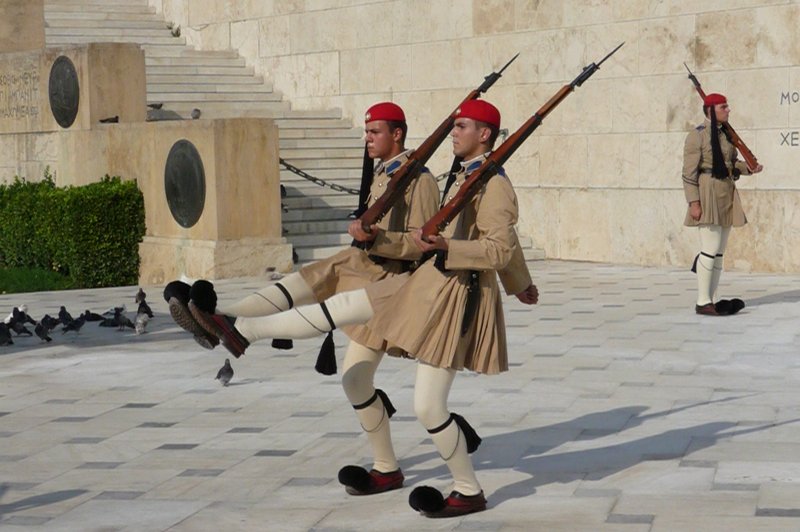 |
| Changing of the Guard at Parliament, Athens |
In retrospect, we found Athens to be much cleaner and user-friendly than we had anticipated. In all of our experiences with taxis, the drivers were polite and used the meter, although we did have to share cabs on a couple of occasions, which is customary in Greece. For longer trips, the Athens Metro system is inexpensive, efficient and easy to navigate.
Our Auckland yacht racing mate Mandy flew in from London and joined us for a week of cruising. Soon after she arrived, we threw off the lines and departed the hustle and bustle of Piraeus and headed west. Our first stop was an anchorage off the town of Isthmia, and as usual we reached it just in time for happy hour.
The town of Isthmia is located on the isthmus where the large mass of land called the Peloponnesus was once connected to the rest of mainland Greece. In ancient times, ships were literally dragged across the 3.2 mile isthmus, saving about 600 miles of sailing to get to the Ionian Sea. The Corinth Canal was finally cut through the solid rock isthmus in the late 19th century allowing small ships and boats to pass through.
We tied up near what was labeled the “Customer Service” office of the Corinth Canal to pay for our transit. I’m not sure what service they provided – we tied up the boat, I walked in to pay, and we drove Moonshadow through the canal. At €320 (US $470), the 3.2 nautical mile long Corinth Canal cost us more to transit than either the Panama or Suez Canals. Given that the Suez Canal is around 90 miles long and the Panama Canal is around 50 miles long (and has six locks), this little ditch is really a gold mine for the Greeks. Perhaps they think that accepting credit cards for the transit fee is service. the draw bridges located at either end are one cool feature of the Corinth Canal. Instead of lifting up or swinging, the center span sinks down and disappears into the water and you can see the roadway on the bottom as you sail over it. Otherwise our transit was an A-ticket ride. Yawn.
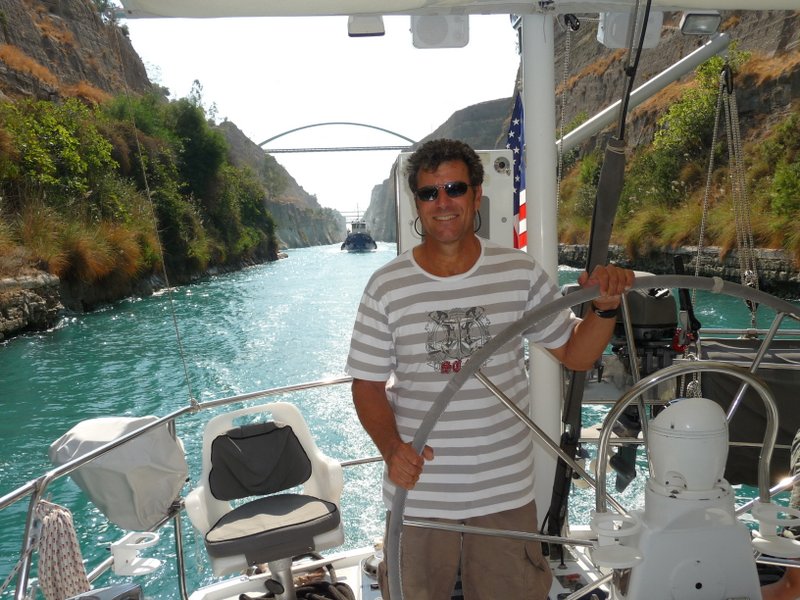 |
| Transiting the Corinth Canal |
With the Corinth Canal and a load of Euro in our wake, we headed northeast across the Gulf of Corinth to the lovely little town of Galaxhidi. The people of the village were very friendly and curious. Most of the century-plus old village homes were well-restored and colorfully painted, in stark contrast to many of the villages we visited in the Aegean Sea where most homes are in shades of white. A rather talkative, self-appointed harbormaster who called himself “Number One” organized a taxi to take us up to Delphi the next morning.
A half hour ride from Galaxhidi in a luxurious Mercedes Benz taxi and we were in the ancient sanctuary of Delphi. Situated on a steep mountainside, the setting of Delphi is nothing short of spectacular. On the day we visited the weather was perfect, lending to the extraordinary serenity of the site. We spent a few hours wandering through the remarkable ruins and the adjacent museum before we returned to Galaxhidi.
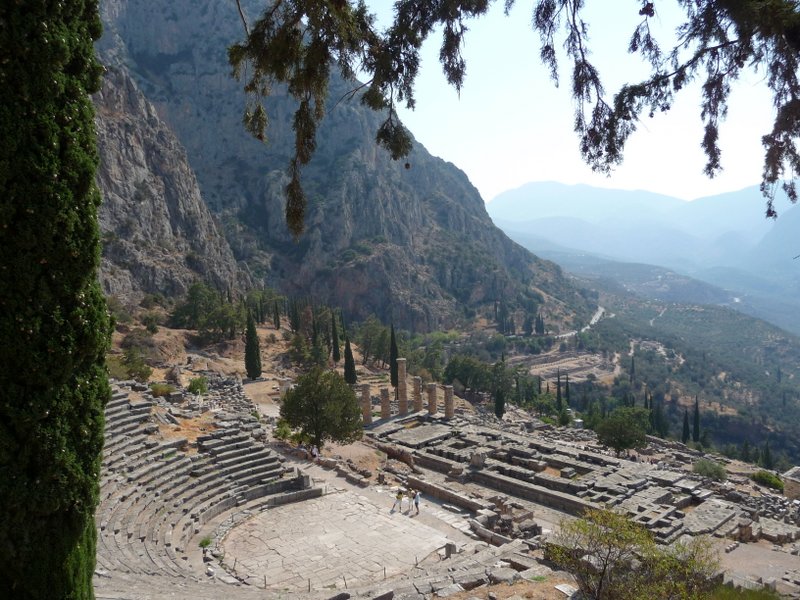 |
| The serenity of Delphi. |
That afternoon we headed west 22nm to the quiet little island village of Trizonia, and Med-moored to the village quay. By contrast to the Aegean, the Gulf of Corinth had very light breezes throughout the day and the clear waters enticed us to take an afternoon swim.
We continued west again the next day to the village of Nafpaktos. The oval-shaped medieval walled harbor was a bit too cozy for us to Med-moor inside, but we found comfortable anchorage in the calm waters of the bay just outside. On the hillside overlooking the picturesque village is a Venetian castle, adding to the overall charm of the place. That evening we went ashore for a stroll, drinks, and an excellent dinner in a waterfront taverna and were surprised at the number of trendy bars and cafes filled with very hip-looking young people.
A calm morning anchored off the village of Nafpaktos
Our next leg was a full day’s run out through the Gulf of Patra and into the Ionian Sea to the Island of Ithaca. Just as we entered the harbor at Vathi town after a day of motor-sailing in light airs, the wind suddenly piped up to 30 knots and was blowing right in through the harbor entrance. Looking for a little better protection and more swinging room, we headed back out and anchored at the head of the Gulf of Molo. The winds abated a few hours later and the next morning we found ourselves in the lee of a rubbish dump so the odors wafting down the hillside were a bit unpleasant. We returned to Vathi and took anchorage in the harbor. We enjoyed a stroll around the town and that evening returned to celebrate Merima’s birthday at an excellent taverna run by a Greek family that had returned to the motherland after spending many years in New York.
We headed north the next day and stopped at a lovely anchorage called One House Bay on the little island of Atoko. After a swim in the crystal clear waters and lunch, we weighed anchor and headed to the “island” of Levkas. Levkas was once part of Mainland Greece, but in ancient times a canal was cut through the marshy isthmus enabling smaller vessels to navigate between them.
 |
One House Bay, Atoko Island
At the north end of Lefkas is what the Lonely Planet described as a “smart new marina.” Two years after the publication date I can tell you unequivocally that it is neither. The prices are the only thing five-star about this marina. Upon our arrival we were underwhelmed by the lack of helpfulness on the part of the dock attendants. Useless would be the most polite adjective to describe them. The shower and toilet facilities were absolutely disgusting. The on-site mini market was terribly overpriced. In a southerly breeze, the marina is situated just downwind from a rubbish dump, with fires endlessly smoldering and sending along its malodorous smoke. Dead fish and rubbish congregated in the water and we never saw anyone making any attempts at a cleanup. The WiFi system had been down for more than a month with no repair date anticipated. All this for the highest price we’ve ever paid for a marina. If the marina was a loser, Lefkas town was a pleasant enough place and at least Moonshadow would be secure while we took off for a few days of inland travel. We all enjoyed a meal in town featuring some Lefkadan specialties that evening.
We bid Mandy a farewell as she caught a bus back to the airport in Athens and we prepared to head inland to Meteora.
Driving in Greece is an exciting, if not terrifying experience. The roads are generally good and navigation is not difficult as most signs show place names in both Greek and Roman characters. Along our route we were teased with a new stretch of freeway that was being built to transverse the country from coast to coast (Ionian to Aegean). This road was of Autobahn quality, featured some very long tunnels through the mountains and the speed limit was posted at 130 kph (80 mph) for cars. As if our rented Fiat Punto could even reach that speed! Back on the old roads, stuck behind slow trucks with no passing lanes to be found, we could understand why the road toll in Greece is reportedly the highest in Europe. Greek drivers love to drive fast, are very impatient and overtake slower vehicles at every opportunity. We witnessed dozens of extremely close calls in the hours we were on the road. We split up the five hour drive with a lunch stop in the quaint mountain hillside village of Metsovo. From there it was a couple more hours on a winding road to the village of Kastraki in the extraordinary area called Meteora.
Rising above the valley are massive rock pinnacles, which themselves are quite a spectacular sight. During the Byzantine era, reclusive monks seeking peaceful havens from the Turkish incursions into Greece built numerous monasteries on the tops of these lofty rock pinnacles. Originally the only access was by rope ladders or in rope nets hauled up by a hand-cranked windlass. Some of these spectacular monasteries sit precariously perched on pinnacles that loom hundreds of feet above the surrounding ground level.
Rousanou (foreground) and Saint Nicholas Anapafsas (behind) Monastaries, Meteora
A handful of the original monasteries remain and most of these are now open to the public. Oh, yes, stairways have been carved out of or built on to the rock so that visitors can now walk up safely. We visited three of the monasteries on a rather drizzly and overcast day. All were quite impressive, and the largest, Moni Megalou Meteorou was literally a self-contained village situated on the top of a massive pinnacle. Fortunately the weather cleared and the following day was absolutely brilliant. We took the opportunity to drive or walk to some of the spectacular vista points along the ridge overlooking the monasteries and the valley below.
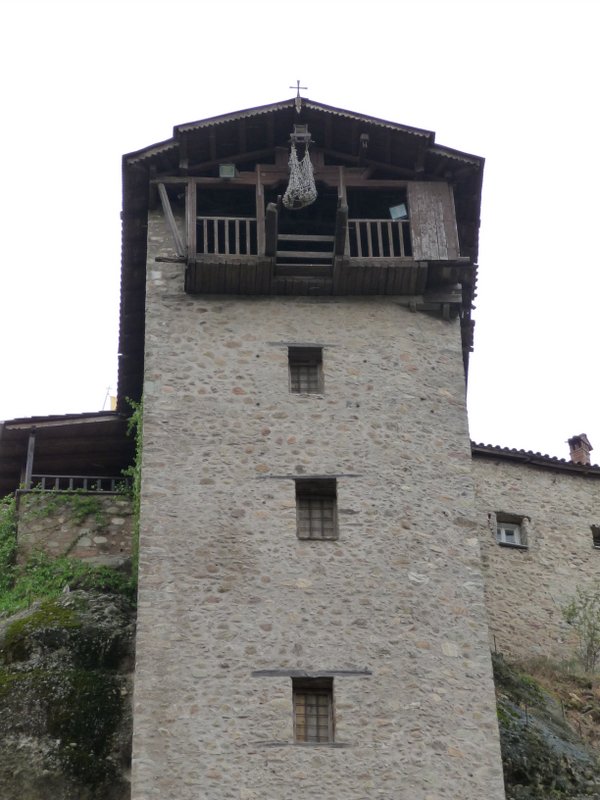 |
| The net used for lifting people and goods up to the monastery |
The winds abated overnight so we headed out the following morning and easily made the 30nm trip to Paxos. We tied up to the quay in the lovely little town. It was quite busy with tourists during the day, but by late afternoon most of them were on a boat back to Corfu so the evenings were very serene. On the Friday night we had a huge downpour. This was the first time we had experienced any measurable rain on board in more than a year. Finally the rig and halyards got a cleaning from the Meltemi dust. We chilled out in Paxos for a couple days and waited for favorable weather to make the trip up to Corfu.
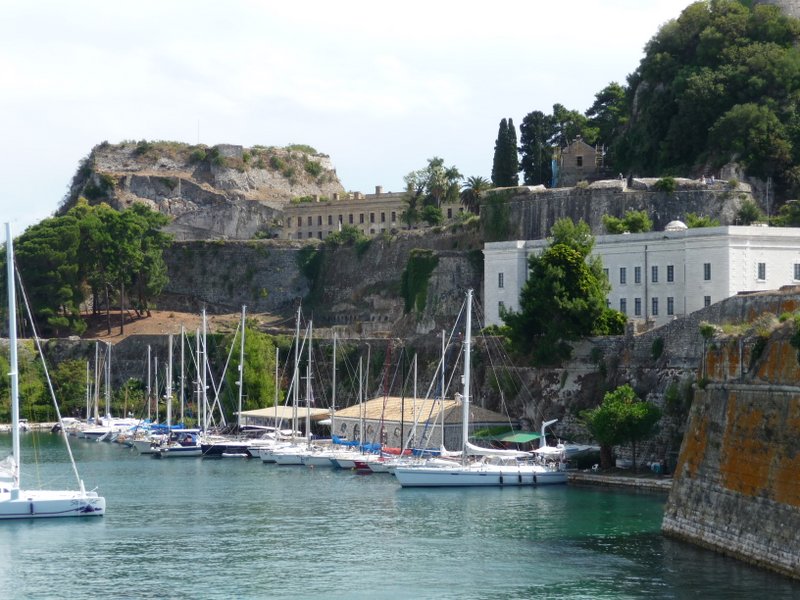 |
| The Corfu Sailing Club |
The strong northerlies eased and we motor-sailed from Paxos to Corfu. The small municipal harbor was chocker with fishing and day tripper boats, but we were able to find berthing at the Corfu Sailing Club. Nestled under the north side of the Corfu’s old castle, the Corfu Sailing Club is a convivial little marina. It is a bit ramshackle and quarters for maneuvering are tight, but it has all the facilities necessary for a cruiser: power, water, toilets, showers, a diesel pump, WiFi, social area, bar and restaurant. Prices were reasonable and it was just a five minute walk to the center of Corfu town.
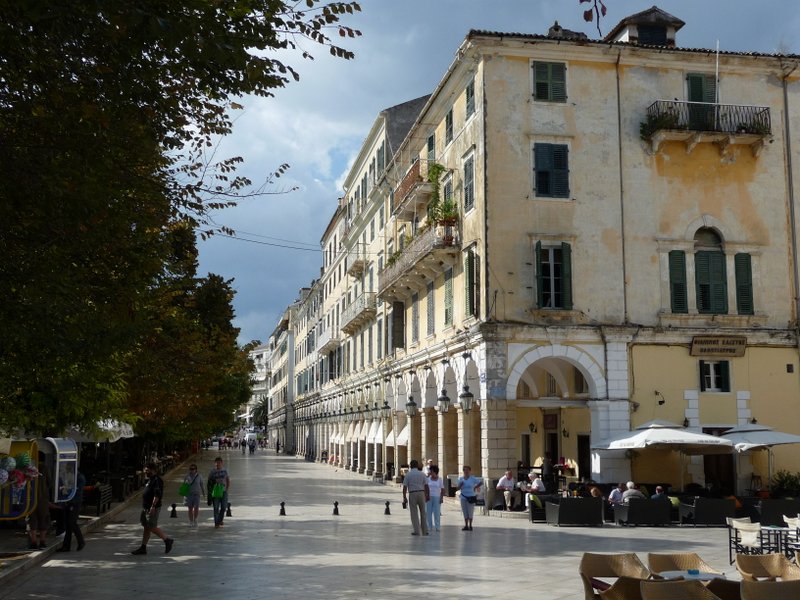 |
| Beautiful old buildings along the Liston, Corfu |
In stark contrast to the laid-back villages typical of the Greek Islands, Corfu town is a decidedly sophisticated city. With its Venetian mansions, broad promenades, spacious parks, trendy cafes and upscale shops, it is where Greece meets the rest of Europe. One can easily get lost meandering through the labyrinth of narrow streets in the quaint old town. There were, of course, the ubiquitous tourist shops selling the usual Greek curios, many of which had probably been made in China. The most surprising offering were wooden carvings of Komodo Dragons. Not exactly a Greek thing. We’d seen millions exactly like them in Indonesia, Singapore, Malaysia and even as far away from Komodo as Thailand, but Greece? We enjoyed a few days of relaxing and exploring in Corfu, but with the season winding down, it was time to bid a farewell to Greece.
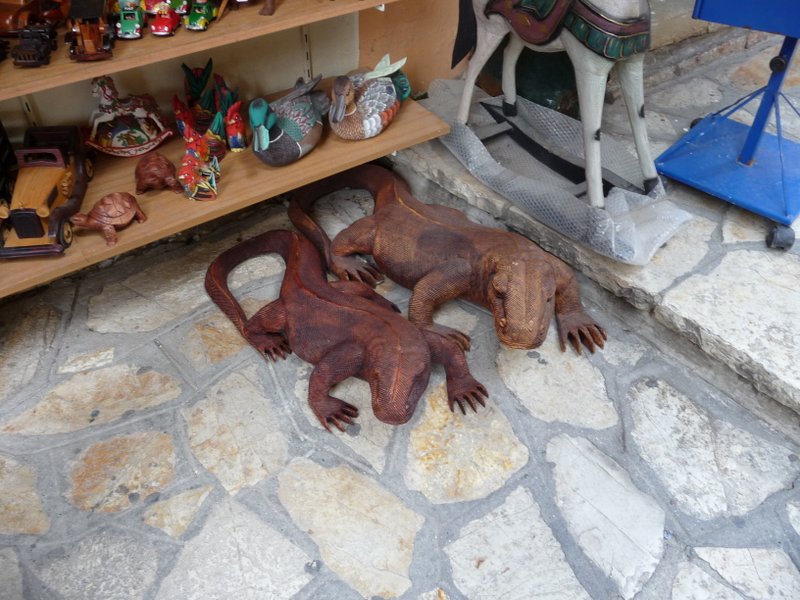 |
| In case you missed the chance in Indonesia, you can get a hand carved Komodo Dragon in Corfu |
I wish it was that simple. Up to this point formalities in Greece had been too easy. Departing Greece for the last time became a real challenge. First off, on the day we wanted to check out, both Customs and Immigration had gone on strike. Once again, this is Greece! Thinking it was mandatory to check out with both offices, we persisted in rustling up some people who managed to relieve us of our Transit log and glance at our passports, but not after being sent to and fro from office to office. Unlike most other Greek ports, Corfu’s officials are spread out all over the waterfront along the city’s huge commercial and ferry port, so the process involved miles of walking. As it turned out, we could have simply mailed in our Transit Log and we were told we didn’t need a departure stamp in our passports as we were bound for another EU country. What a huge waste of time!
 |
| A view of Corfu Town from the Old Castle |
We slipped out of Corfu the next morning and anchored off of the quiet little island of Othoni, lying off the northwest corner of Corfu. From there it would be an easy 46nm trip to the port of Otranto, on the heel of the boot of Italy.

